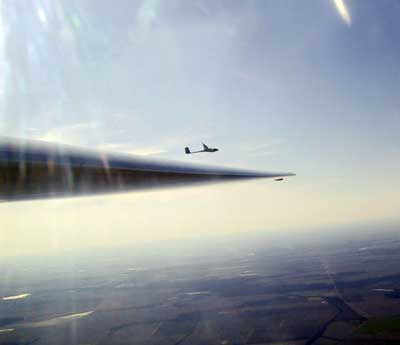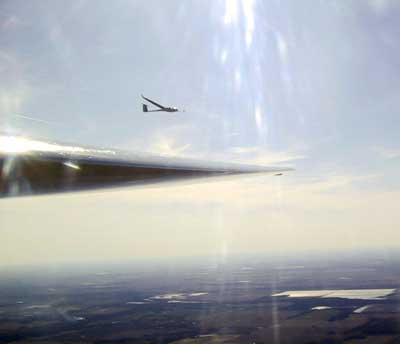|
|
First Parallel Flight: More Encouraging Data (3/19/2005)
On March 19, 2005, Standard Cirrus #60 (N2866) was flown in parallel with an ASW-28 standard class glider (N228DC) at 80 kts. The Standard Cirrus was equipped with a prototype version of Dr. Sinha's deturbulator tape over the full span of the upper wing surfaces. The lower wing surfaces were in their standard configuration, clean except for mylar aileron gap seals. For those who do not know, the Standard Cirrus is a 36 year old design that used Wortmann airfoils that have long since been eclipsed by newer, more laminar airfoils. The ASW-28 is the latest and arguably the best standard class glider available today. The best lift-over-drag ratio for the Standard Cirrus is 36:1. The manufacturer claims 45:1 for the ASW-28. Otherwise, the wing areas, aspect ratios and loadings for these ships are similar. This was not a planned comparison of the two gliders over a full range of airspeeds at high altitudes where smooth air would permit a precise comparison. It was merely a chance encounter, an opportunity to corroborate sink rate measurements that we are collecting on the modified Standard Cirrus. It was a single side-by-side glide of 5.3 nautical miles at 80 knots airspeed. 80 knots was chosen because it is known to be a speed where the Sinha deturbulator is especially effective on the top surface of the Standard Cirrus wing. Figure 31 shows the logged altitudes in feet MSL of the two gliders vs. time in seconds. The solid blue points are the ASW-28 altitudes and the open red points are for the Standard Cirrus. A thin blue solid line is a best linear fit to the ASW-28 data. A thicker solid red line similarly fits the Standard Cirrus data. The thin dashed red line is an estimate of the expected performance of the unmodified Standard Cirrus glider vs. the ASW-28. This is based on measured performance of the Standard Cirrus in this test as well as another one, measured by Dick Johnson in the early 1970s, relative to factory claims for a lightly loaded ASW-28 like the one in this test. Without the linear fits, it would be difficult to see any difference in the two gliders at all. In fact, the pilot of the ASW-28, an experienced pilot of many years, a competition soaring pilot and an FAA designated examiner, remarked at the end of the glide that he saw "no practical difference" in the two gliders over the course flown. However, the different slopes of the two solid lines reveal that the Standard Cirrus was sinking about 6% faster than the ASW-28. This may not seem very good, but it is only 1/3rd the difference that an unmodified Standard Cirrus should see. In other words, about 2/3rds of the performance gap at 80 kts between the 36 year old Standard Cirrus and the best glider design technology available today has been bridged by a preliminary, top-surface-only application of Sinha deturbulator. This is even more impressive when you consider that the Standard Cirrus wings are an old, thick design that carries a draggier fuselage and tail section through the air. Furthermore, this Standard Cirrus has tubes taped along 150 inches of the trailing edge of the right wing and down the side of the fuselage. Not to mention that it is not in the pristine condition of the ASW-28. The point is that the old wings have to be additionally efficient to overcome this baggage. If it were a comparison of identical aircraft with and without deturbulator, the improvement would be greater. Figures 32 and 33 are photographs of the ASW-28 off the wing tip of the Standard Cirrus at the beginning and end of the glide respectively. You should not read too much into the higher position of the ASW-28 at the end since the picture was not synchronized with the data and based on the last data points in Figure 31, it appears that I caught the ASW-28 on a bounce. What really count are the slopes of the gliders' paths over the entire glide. At this point we are assessing the top-wing-surface-only deturbulation of the Standard Cirrus before proceeding with a lower surface application. When we feel that we have achieved as much as we can with a reasonable amount of effort we will measure a proper polar.
Jim Hendrix |

|

|
| © Copyright 2003-2012 Jim Hendrix | Disclaimer |